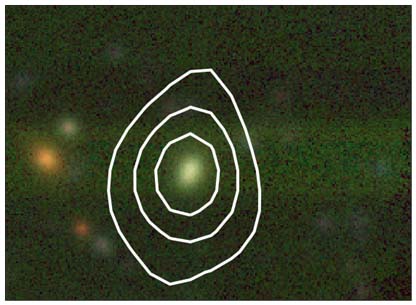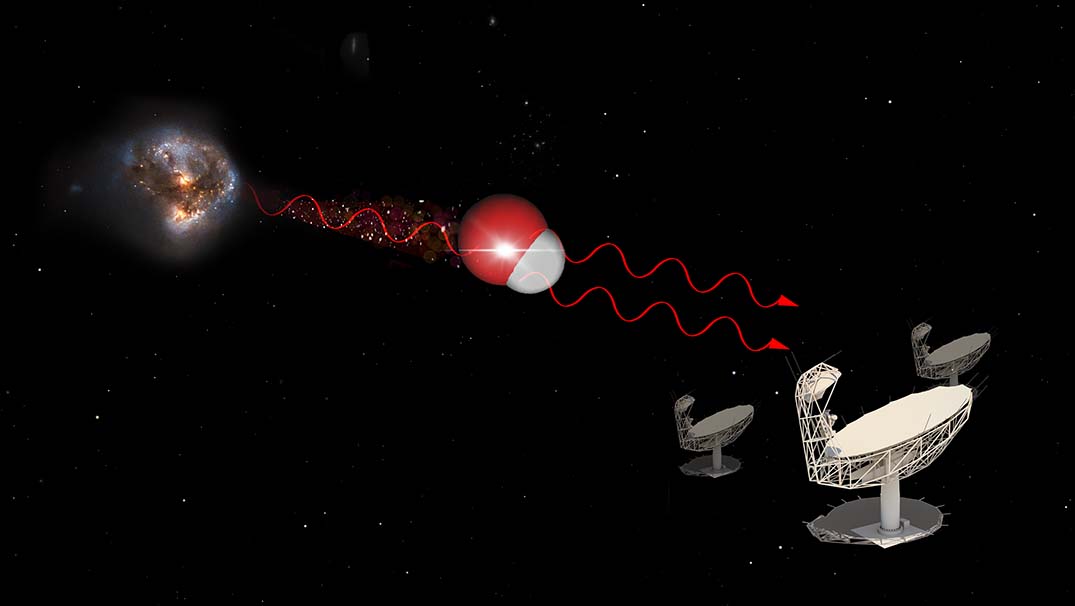A powerful, naturally occurring “space laser”, called a megamaser, has been discovered with South Africa’s MeerKAT radio telescope in a galaxy nearly 5-billion light-years away.
This is the most distant such megamaser found so far, and was probably forged in the collision of two galaxies. The megamaser has been nicknamed “Nkalakatha”, meaning “big boss” in isiZulu.
A maser is just like a laser but in radio waves instead of visible light. When galaxies (like our own Milky Way) collide, this can create extremely bright masers, called megamasers. The maser light comes from hydroxyl molecules inside extremely dense clouds of interstellar gas.
Hydroxyl molecules are also referred to as OH, because they are each made of one atom of oxygen and one atom of hydrogen. OH masers emit a specific radio signal with a wavelength of 18cm.

The “Nkalakatha” megamaser. The galaxy that hosts the megamaser can be seen in the background optical image from the Hyper Suprime-Cam (HSC) on the 8.2m diameter Subaru Telescope. The white contours show the region where the MeerKAT telescope detected the 18cm radio emission of the OH megamaser.
Credit: M. Glowacki Curtin Univ/ICRAR/IDIA/UWC, Laduma.
South Africa’s radio telescope, MeerKAT, is proving excellent for detecting these 18cm signals from far-off megamasers. At nearly 5-billion light years away, Nkalakatha is the most distant megamaser ever discovered in this way.
Nkalakatha was spotted in MeerKAT observations that were taken as part of a project called Laduma – which stands for “Looking at the Distant Universe with the MeerKAT Array”.
“The main goal of Laduma is to use very sensitive radio-wavelength observations of gas in distant galaxies to investigate how galaxies have evolved over the past 9-billion years of cosmic time,” explains Associate Professor Sarah Blyth from the University of Cape Town (UCT) and co-lead of the Laduma project.
“By measuring the neutral hydrogen gas in galaxies from the distant past to now, Laduma will contribute to our understanding of the evolution of the Universe.”
Dr Marcin Glowacki, formerly a researcher at the Inter-University Institute for Data-Intensive Astronomy (IDIA) and UWC, now based at the Curtin University node of the International Centre for Radio Astronomy Research, says: “Although our primary aim is to study neutral hydrogen gas in galaxies, very excitingly, we also expect to find many OH megamasers in our very sensitive data.”
Glowacki is the lead author of the work.
Although the full Laduma project will take more than 3 000 hours of MeerKAT observations to be complete, the Nkalakatha megamaser was discovered after just one night.
“It’s impressive that in a single night of observations with MeerKAT, we already found a record-breaking megamaser,” says Glowacki. “For the Laduma project to have already led to a significant scientific publication at such an early stage is remarkable. We cannot wait to see what other treasures will be uncovered by the rest of the Laduma observations.”
And the outlook is bright: “MeerKAT will probably double the known number of these rare phenomena,” says Professor Jeremy Darling, a megamaser expert and Laduma team member from the University of Colorado.
“Galaxies were thought to merge more often in the past, and the newly discovered OH megamasers will allow us to test this hypothesis. The OH megamasers act like bright lights that say: here is a collision of galaxies that is making new stars and feeding massive black holes.”
The Laduma project consists of a truly international team of researchers, with members from South Africa, Australia, Chile, France, Germany, India, Italy, Japan, the Netherlands, South Korea, Spain, the UK and the US.
UCT is represented by eight team members: Associate Professor Blyth, Dr Jordan Collier, Dr Brad Frank, Professor Matt Bershady, Professor Erwin de Blok, Dr Jacinta Delhaize, Emeritus Professor Renee Kraan-Korteweg and PhD candidate Munira Hoosain.
Featured picture: Artist’s impression of a hydroxyl maser. Inside a galaxy merger are hydroxyl molecules, composed of one atom of hydrogen and one atom of oxygen. When one molecule absorbs a photon at 18cm wavelength, it emits two photons of the same wavelength. When molecular gas is very dense, typically when two galaxies merge, this emission gets very bright and can be detected by radio telescopes such as the MeerKAT.
Credit: IDIA/Laduma using data from NASA/StSci/SKAO/MolView

